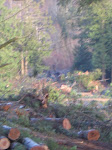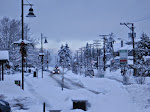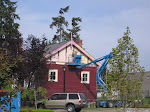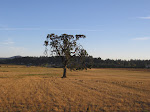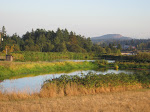http://cnews.canoe.ca/CNEWS/Canada/2009/01/01/7896541-cp.html
Top CEOs earn average Canadian annual salary in hours
By Colin Perkel, THE CANADIAN PRESS
TORONTO - As many Canadians nurse their post-New Year's Eve hangovers and ponder what further economic storms await, Canada's top corporate executives can take some comfort in knowing they have already earned as much as the average worker will earn in all of 2009.
A new analysis by the left-leaning Canadian Centre for Policy Alternatives concludes the country's richest corporate executives will have pocketed an average of $40,237 by 9:04 a.m. Friday morning.
"By the time your computer has finished booting up on your first day back after the New Year's holiday, the average CEO would have already banked what took the average Canadian worker an entire year's worth of work to earn," the report states.
"Many of the top 100 include Canada's big bank CEOs, who recently received billions in federal government bailout money to purchase mortgage loans." Prepared by economist Hugh Mackenzie, the report finds the top 100 CEOs of publicly traded corporations averaged more than $10 million in pay apiece in 2007, the last full year for which figures are available. That kind of money would buy 44 high-end Porsches or five $2-million condos.
The collective billion-dollar bonanza - a 22 per cent increase over the year before - set a record and followed a decade of unprecedented pay increases, the analysis finds. Roger Martin, dean of the Rotman School of Management, said the gap between low-end and highest-end earners began growing in earnest in the 1980s and accelerated in the 1990s, something Martin attributed essentially to greed.
The question for CEOs changed from how much they felt they needed to earn to how much could they could "possibly extract" from their companies, an attitude detrimental to the company and their employees.
"Rank-and-file employees will increasingly feel like, 'Wow, I'm working hard to make that guy really, really rich. Do I like that?"' Martin said.
The report is based on disclosures made by companies trading on the Toronto Stock Exchange. The compensation includes salaries, bonuses, proceeds from stock options and other payouts.
The top earner, according to the report, was Michael Lazaridis, head of BlackBerry maker Research In Motion based in Waterloo, Ont., who pocketed more than $51 million.
Martin said current ways of thinking about CEO compensation are "just dead wrong." "A lot of the CEOs have a compensation formula that still compensates them wonderfully while they're not creating value or even destroying value - laying off people and the like," Martin said.
Incentives they are offered tend to encourage unhealthy and even disastrous risk-taking as senior executives seek to maximize their own earnings, often at the expense of shareholder interests, Martin said.
Despite the market meltdown and hammering of the economy that is costing thousands of workers their jobs, Mackenzie said CEO earnings for 2008 could be as high as they ever were.
"In a rational world, you would expect a big drop in executive compensation in 2008 and again this year," Mackenzie said in an interview.
But in a rational world, he said, one wouldn't expect to see the average pay of the top 50 executives rising from 104 times the average income in 1995 to almost 400 times.
Martin said CEOs should suffer along with employees and shareholders when times are tough.
Repercussions from the economic crisis may yet force them to do so. The report notes a backlash in the United States against huge salaries and severance packages paid to executives even as their company share prices and performance plummet.
"It's only a matter of time before this new reality takes root in Canada," the report says. -
Some facts about the top 100 Canadian CEO earnings
TORONTO - An analysis out Friday by the Canadian Centre for Policy Alternatives finds top earnings for Canada's top 100 CEOs have soared in recent years.
Some facts (figures based on 2007 unless otherwise noted):
Average annual CEO earnings: $10,408,054
Increase over previous year: 22 per cent
Average annual pay for Canadians: $40,237
Number of CEOs to earn total income of Nunavut: 25
Point at which CEO earns annual salary of average Canadian: Jan. 2, 9:04 a.m.
Quote: "A lot of the CEOs have a compensation formula that still compensates them wonderfully while they're not creating value or even destroying value - laying off people and the like."
- Roger Martin, dean of Rotman School of Management. Source: Canadian Centre for Policy Alternatives
Saturday, May 16, 2009
Belt-tightening for CEOs FIRST!
Sign the salmon petiton!
Thanks to Alexandra Morton.
If you care about salmon, bears, orca, dolphins, wolves, old growth forest, or fishermen and haven't signed this letter yet, please do it now. Wherever you are in the world, we need your signature to pressure our government into action.
Petition at:http://spreadsheets.google.com/viewform?formkey=cEkxX3p3MGFBbWNVVGNVU3lxQnBwQmc6MA ..
Background at: http://www.adopt-a-fry.org/
Forwarded message:
Dear Folks
Our letter has become too big to send to all of you, I will try to post it later today on www.adopt-a-fry.org. This email below and the letter went to the Minister and the Premier a few minutes ago.Please see the Globe and Mail article below. I believe we will need 2-3 times the signatures we have now to move government to do the right thing.My deepest thanks to all of you alexandraDear Minister of Fisheries the honourable Gail Shea and Premier Campbell:As noted in the Globe and Mail this morning, I have been sending you this letter for a month with no reply. What began with 100 signatures from local fishermen has grown to 7,309 signatures from around the world, but predominately British Columbia (5,785).Premier Campbell, your government has allowed this industry to expand in the face of the most alarming wild salmon declines we have ever seen on this coast.Minister Shea, this is not a situation of your making, but you have the opportunity to bring reason to this mess.I will continue to take signatures to help you move past status quo and bring salmon “farming” into compliance with the laws of Canada. BC Supreme Court ruled they are no longer “farms,” they are a fishery. There is debate now as to whether Marine Harvest and the other salmon “farming” companies actually own their fish when they put them into Canadian waters,All we are asking is for the Fisheries Act to be applied to this industry. As wild salmon decline all the other related fisheries have been increasingly restricted.....except the marine feedlot fishery. This is a threat to our coastal communities and the economy of British Columbia.Standing by,Alexandra MortonTo sign the petition to apply the Fisheries Act to fish farms the way it is applied to fishermen please click on the link below. http ://spreadsheets.google.com/viewform?formkey=cEkxX3p3MGFBbWNVVGNVU3lxQnBwQmc6MA. .
The Globe and Mail
Fisheries ignored 500 names. Can it ignore 5,000?
by Mark Hume March 23, 2009
VANCOUVER -- The form letter that Premier Gordon Campbell and federal Fisheries Minister Gail Shea keep ignoring is just getting longer. In circulation for only a few weeks, it already has nearly 5,000 signatories, and more names are being added daily as it circulates on the Web.
When it first went to the politicians, 500 names were affixed. It was ignored, so it went back into circulation and soon was resubmitted with 2,000 names, then with 4,000. It's making the rounds again this week, and is still growing.
Started by research scientist and fisheries activist Alexandra Morton, the letter asks the government to take decisive action to protect wild salmon from the threats posed by salmon farms. One of the key requests is that salmon farms be moved away from wild salmon migration routes because of the transmission of sea lice from caged fish.
The people who signed the letter worry that salmon farms are an unacceptable risk to wild stocks. And that fear is about to be heightened by a study being released today that shows juvenile sockeye from the Fraser River are encountering fish farms at an alarming rate.
Michael Price, a biologist with Raincoast Conservation Foundation, and Craig Orr, executive director of Watershed Watch, studied 800 wild sockeye collected in 2007-08 in northern Georgia Strait. About 70 per cent of those fish had one to 20 sea lice attached to them. And the fish caught near farms were the most likely to be infected.
"The lice levels appear to be higher near farms," said Mr. Price, who is still analyzing the data.Past studies by Ms. Morton have documented the spread of lice from farms to wild pink and chum salmon in the Broughton Archipelago, an area off Vancouver Island's northeast shoulder. But the study by Mr. Price and Dr. Orr looks at sockeye, and for the first time uses DNA analysis to trace the infected fish to their watershed of origin.The researchers conclude most of the sockeye they caught migrating near salmon farms (60 per cent in 2007 and 99 per cent in 2008) came from the Fraser River.
Sockeye are the most valuable of all salmon species because they draw a higher price on the market and because they are the fish of choice for native food and ceremonial fisheries. Mr. Price and Dr. Orr have now linked the most valuable fish, from B.C.'s most important salmon river, to farms and lice. Mr. Price said juvenile sockeye can follow three routes as they migrate through Georgia Strait on the outward leg of their journey to the Gulf of Alaska.
"But all these routes converge before the Broughton Archipelago [at the north end of Georgia Strait] where there are a dozen farms," he said. "It's clear that no fish can make this journey without encountering a farm."
Mr. Price said studies have shown that one to three lice can kill a juvenile pink salmon, so it's fair to assume sockeye are dying as well. Could this help explain the collapse of Fraser River sockeye stocks? Some people will no doubt find this an alarming possibility.
The form letter, triggered by concerns about pink and chum, describes wild salmon as "the backbone of the B.C. Coast," and urges both Ms. Shea and Mr. Campbell to protect migrating wild stocks from fish farms. So far, the politicians have been able to ignore the ever-growing letter. But the new study can only ratchet up the pressure. Now that people know it's not just pink salmon, but Fraser River sockeye stocks that are at risk, one has to wonder how many more names will get added to that letter.
If you care about salmon, bears, orca, dolphins, wolves, old growth forest, or fishermen and haven't signed this letter yet, please do it now. Wherever you are in the world, we need your signature to pressure our government into action.
Petition at:http://spreadsheets.google.com/viewform?formkey=cEkxX3p3MGFBbWNVVGNVU3lxQnBwQmc6MA ..
Background at: http://www.adopt-a-fry.org/
Forwarded message:
Dear Folks
Our letter has become too big to send to all of you, I will try to post it later today on www.adopt-a-fry.org. This email below and the letter went to the Minister and the Premier a few minutes ago.Please see the Globe and Mail article below. I believe we will need 2-3 times the signatures we have now to move government to do the right thing.My deepest thanks to all of you alexandraDear Minister of Fisheries the honourable Gail Shea and Premier Campbell:As noted in the Globe and Mail this morning, I have been sending you this letter for a month with no reply. What began with 100 signatures from local fishermen has grown to 7,309 signatures from around the world, but predominately British Columbia (5,785).Premier Campbell, your government has allowed this industry to expand in the face of the most alarming wild salmon declines we have ever seen on this coast.Minister Shea, this is not a situation of your making, but you have the opportunity to bring reason to this mess.I will continue to take signatures to help you move past status quo and bring salmon “farming” into compliance with the laws of Canada. BC Supreme Court ruled they are no longer “farms,” they are a fishery. There is debate now as to whether Marine Harvest and the other salmon “farming” companies actually own their fish when they put them into Canadian waters,All we are asking is for the Fisheries Act to be applied to this industry. As wild salmon decline all the other related fisheries have been increasingly restricted.....except the marine feedlot fishery. This is a threat to our coastal communities and the economy of British Columbia.Standing by,Alexandra MortonTo sign the petition to apply the Fisheries Act to fish farms the way it is applied to fishermen please click on the link below. http ://spreadsheets.google.com/viewform?formkey=cEkxX3p3MGFBbWNVVGNVU3lxQnBwQmc6MA. .
The Globe and Mail
Fisheries ignored 500 names. Can it ignore 5,000?
by Mark Hume March 23, 2009
VANCOUVER -- The form letter that Premier Gordon Campbell and federal Fisheries Minister Gail Shea keep ignoring is just getting longer. In circulation for only a few weeks, it already has nearly 5,000 signatories, and more names are being added daily as it circulates on the Web.
When it first went to the politicians, 500 names were affixed. It was ignored, so it went back into circulation and soon was resubmitted with 2,000 names, then with 4,000. It's making the rounds again this week, and is still growing.
Started by research scientist and fisheries activist Alexandra Morton, the letter asks the government to take decisive action to protect wild salmon from the threats posed by salmon farms. One of the key requests is that salmon farms be moved away from wild salmon migration routes because of the transmission of sea lice from caged fish.
The people who signed the letter worry that salmon farms are an unacceptable risk to wild stocks. And that fear is about to be heightened by a study being released today that shows juvenile sockeye from the Fraser River are encountering fish farms at an alarming rate.
Michael Price, a biologist with Raincoast Conservation Foundation, and Craig Orr, executive director of Watershed Watch, studied 800 wild sockeye collected in 2007-08 in northern Georgia Strait. About 70 per cent of those fish had one to 20 sea lice attached to them. And the fish caught near farms were the most likely to be infected.
"The lice levels appear to be higher near farms," said Mr. Price, who is still analyzing the data.Past studies by Ms. Morton have documented the spread of lice from farms to wild pink and chum salmon in the Broughton Archipelago, an area off Vancouver Island's northeast shoulder. But the study by Mr. Price and Dr. Orr looks at sockeye, and for the first time uses DNA analysis to trace the infected fish to their watershed of origin.The researchers conclude most of the sockeye they caught migrating near salmon farms (60 per cent in 2007 and 99 per cent in 2008) came from the Fraser River.
Sockeye are the most valuable of all salmon species because they draw a higher price on the market and because they are the fish of choice for native food and ceremonial fisheries. Mr. Price and Dr. Orr have now linked the most valuable fish, from B.C.'s most important salmon river, to farms and lice. Mr. Price said juvenile sockeye can follow three routes as they migrate through Georgia Strait on the outward leg of their journey to the Gulf of Alaska.
"But all these routes converge before the Broughton Archipelago [at the north end of Georgia Strait] where there are a dozen farms," he said. "It's clear that no fish can make this journey without encountering a farm."
Mr. Price said studies have shown that one to three lice can kill a juvenile pink salmon, so it's fair to assume sockeye are dying as well. Could this help explain the collapse of Fraser River sockeye stocks? Some people will no doubt find this an alarming possibility.
The form letter, triggered by concerns about pink and chum, describes wild salmon as "the backbone of the B.C. Coast," and urges both Ms. Shea and Mr. Campbell to protect migrating wild stocks from fish farms. So far, the politicians have been able to ignore the ever-growing letter. But the new study can only ratchet up the pressure. Now that people know it's not just pink salmon, but Fraser River sockeye stocks that are at risk, one has to wonder how many more names will get added to that letter.
Sunday, May 3, 2009
LET THEM EAT CAKE! The Real BC Scandal.
The most important issue facing this province is being almost totally neglected in this campaign.
In eight years the Campbell Liberals have built no subsidized housing for families even though the dire need grows daily. Thousands of people, most of them children, are waiting for safe, healthy housing that is subsidized so that parents aren't spending 80% of their income on shelter. Thousands are living in mouldy, rat-infested units that compromise health and safety. Thousands are living in crowded conditions, in run down homes with electrical and plumbing problems. Thousands go hungry to keep an inadequate roof over their heads.
How do children grow and what do they learn when society leaves them in these shameful conditions? The private market can’t help these children. This is the job of government and if we weren't wasting the money on mega-projects we would easily be able to care for the vulnerable folks among us.
I don't know about you, but I expect my taxes to be used to keep my fellow citizens healthy and safe.
The real scandal isn't speeding tickets and drunk driving. The real scandal is the "let them eat cake” attitude of the ignorant, arrogant Campbell Liberals.
The most important issue facing this province is being almost totally neglected in this campaign.
In eight years the Campbell Liberals have built no subsidized housing for families even though the dire need grows daily. Thousands of people, most of them children, are waiting for safe, healthy housing that is subsidized so that parents aren't spending 80% of their income on shelter. Thousands are living in mouldy, rat-infested units that compromise health and safety. Thousands are living in crowded conditions, in run down homes with electrical and plumbing problems. Thousands go hungry to keep an inadequate roof over their heads.
How do children grow and what do they learn when society leaves them in these shameful conditions? The private market can’t help these children. This is the job of government and if we weren't wasting the money on mega-projects we would easily be able to care for the vulnerable folks among us.
I don't know about you, but I expect my taxes to be used to keep my fellow citizens healthy and safe.
The real scandal isn't speeding tickets and drunk driving. The real scandal is the "let them eat cake” attitude of the ignorant, arrogant Campbell Liberals.
Subscribe to:
Posts (Atom)





